Are you new to e-biking and don’t know which type of electric bike is perfect for you?
Or are you an electric bicycle enthusiast who is looking for their next ride? Maybe you made the mistake of buying prematurely on your first go around, and want to make a more informed choice?
No matter how new, confused, or seasoned you are when it comes to e-bikes, it’s essential to make an informed choice. With that said, many e-bikes fulfill specific purposes. In this article, we’ll be discussing how you can make the best decision possible.
When it comes to e-bike factors, some features will remain the same across types.
For example, the motor, battery, riding experience, durability, and safety will all come in play, no matter if you’re looking for a cruiser, off-roader, or a smaller foldable e-bike for an easier commute.
Always consider the best choice for yourself and your own needs. Don’t rely on the most expensive models, especially if they fail to keep your own criteria as a transportation device. It’s possible to get everything you need from one e-bike, even one that’s more cost-effective.
Let’s look at each type of electric bike you can buy, it’s unique features, and whether or not they provide advantages to you as a rider.
Cruiser E-Bikes

Photo Courtesy: Sol Electric
| Model Name | Weight | Range |
| Tower Beach Bum | 49 lbs (22 kg) | 45 miles (72 km) |
| Blix Sol | 57 lbs (25 kg) | 45 miles (72 km) |
| Magnum Low Rider | 60 lbs (27 kg) | 55 miles (89 km) |
A cruiser bike is designed for casual riding because their frame causes the rider to sit in a very comfortable, upright riding position on a large, comfortable seat. Cruisers often have ‘balloon’ tires with better shock absorption, yet the wheels tend not to have individual shocks.
Handlebars sit slightly more upright than other models, so your posture remains straight up instead of slanted or bent. Many cruisers don’t typically have more than one speed, but you can find a 3-speed version for a higher price.
On a traditional bicycle, cruisers have coaster brakes instead of handlebar brakes. Coaster brakes require you to pedal backward to stop. However, e-bike cruisers have brakes on the handlebars to properly activate the disc brakes.
If you’re looking for a model that can travel short-distances for errands and commuting, pick the cruiser as long as your route is flat. Although the 3-speed models can go up small hills, it’s better to get a mountain bike if you plan on riding on hilly commutes.
Cruisers are more massive than other models, are more fashionable than other e-bikes, and often come in a wide variety of colors. The focus here is comfort – not performance, so you won’t need to worry about the motor or battery too much. Pay more attention to the tires.
Mountain E-Bikes
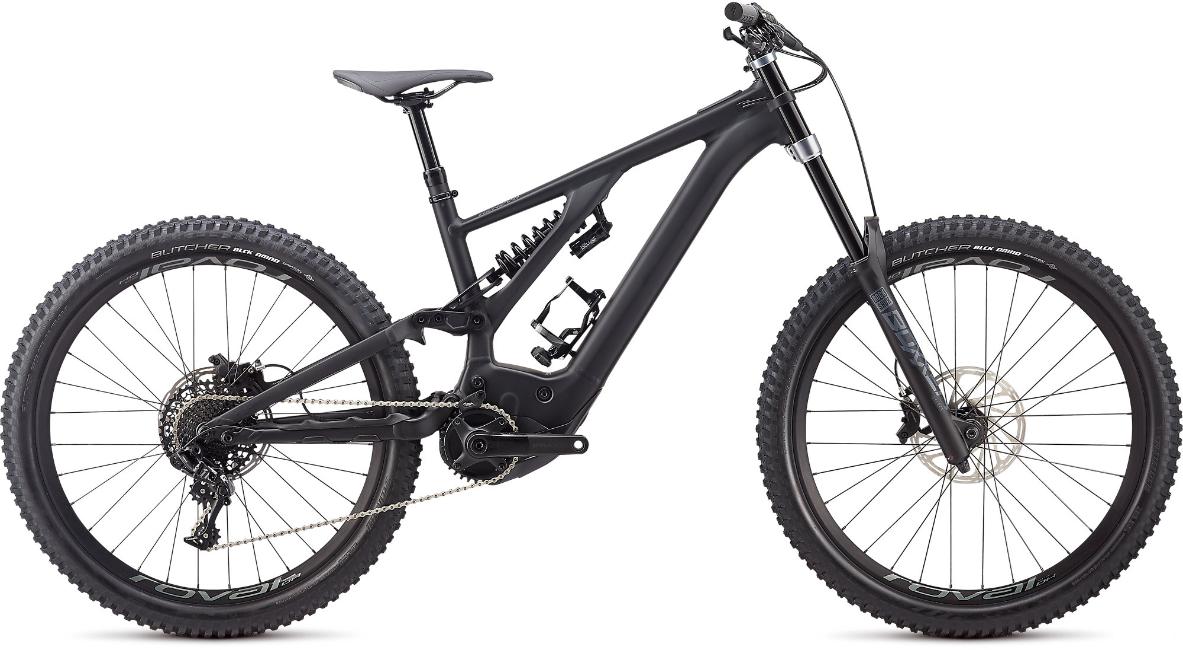
Photo Courtesy: Specialized Kenevo
| Model Name | Weight | Range |
| Specialized Kenevo Expert | 53 lbs (24 kg) | 150 miles (240 km) |
| Samedi 27 Wide 6 | 57 lbs (25 kg) | 90 miles (144 km) |
| Orbea WILD FS M-LTD | 50 lbs (22 kg) | 110 miles (177 km) |
Mountain bikes are designed for off-road trails and rough roads. They have upright, flat handlebars that require a bent or slouched posture to ride correctly. This structure helps you keep your balance when your tires hit bumpy terrain.
Despite its use for uneven ground, mountain bikes tend to have low gear ranges, with what few it has designed for pedaling up steep trails. Most mountain bikes come with some type of shock absorbers or suspension. Front suspension only-bikes are called hardtails, and both front and rear suspension bikes are called full-suspension or duallies.
If you happen to find a mountain bike without suspension, these are called rigid-bikes. It’s not a good idea to purchase a rigid mountain e-bike unless you want to feel every aspect of the road. A lack of suspension will cause an uncomfortable riding experience.
A mountain e-bike is a multi-purpose vehicle because it can be outfitted for use as a commuting or touring bike. However, they wouldn’t be as efficient or light enough to act solely as a commute or touring bike, but they are perfect for casual riding in a pinch.
Fat bikes are included in the mountain e-bike category. Although some mountain bikes are wide enough to fit fat tires, others are not. For adventurers who also want to bike in the snow, pick a fat bike because the tires have enough traction to handle ice and snow.
Riding range is vital for all mountain e-bikes because you’re likely riding in off-road areas that may not have access to refueling stations. Also, ensure the e-bike’s frame is compatible with your height and size, so you aren’t hurting your back while crouching. Keep in mind that e-mountain bikes can be really pricey, so be sure you want this model long-term.
Hybrid E-Bikes
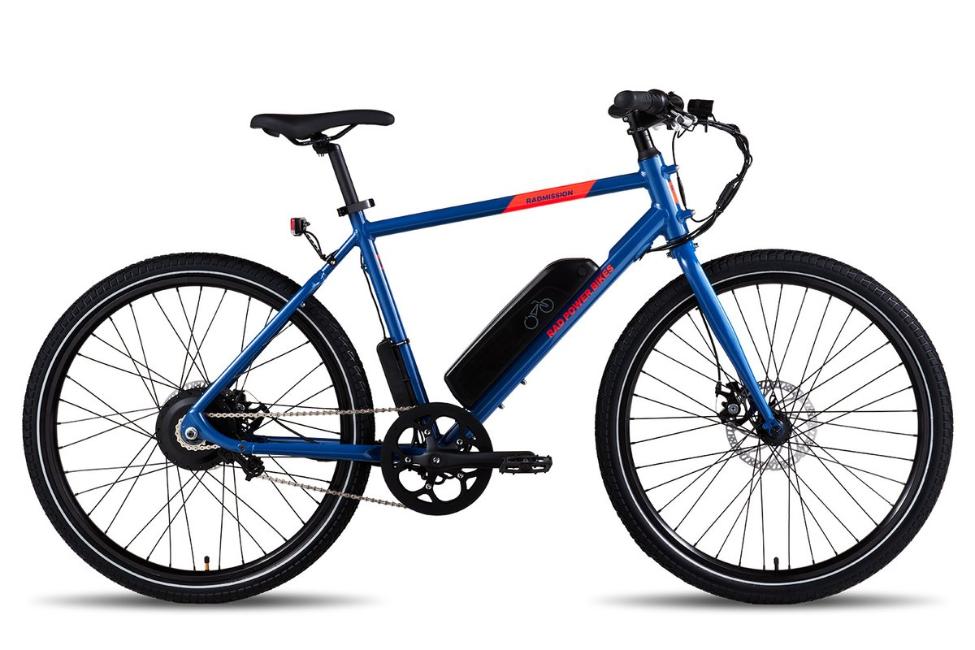
Photo Courtesy: Rad Power
| Model Name | Weight | Range |
| DOST Drop | 64.6 lbs (29 kg) | 120 miles (193 Km) |
| RadMission 1 | 50 lbs (22 kg) | 45 miles (72 km) |
| SONSORS Smart Step | 65 lbs (29 kg) | 40 miles (64 km) |
Hybrid e-bikes were created to provide the advantages of both mountain bikes and road bikes in one complete package. They typically have upright handlebars and padded seats for a more relaxed riding position and a straight/slightly bent posture.
Best for casual riding on bike paths and around the neighborhood, if you’re commuting for short distances for errands, hybrid e-bikes are a great option. They function adequately for paved roads, although they aren’t as efficient or lightweight as road bikes.
Where hybrid e-bikes shine are on unpaved or paved bike trails, but they won’t be adequate enough for off-roading like a mountain bike is. Although the tires will provide a smooth ride on pavement, their semi-smooth, medium-width treads don’t have enough grip or shock absorption or cushion for practically anything else.
If a hybrid bike has suspension, you’ll only find it in the front to smooth out small bumps. However, rigid suspension (or lack there-of) is more common. They used to be called cross bikes, but this was changed to avoid confusion with cyclocross bikes.
Hybrid e-bikes are a ‘jack-of-all-trades and a master of none.’ Someone who is looking for the benefits of most e-bikes may find a hybrid model appealing. Mostly focus on the range and battery charge time because you’ll likely use a hybrid for commuting.
Since commuting will be your ultimate goal, safety should be another focus. Check the price and the warranty to ensure dings and scratches are covered, because you’ll likely see some wear and tear during road-biking. Spend only for a model that will fulfill your needs, and only upgrade to something like a mountain or cruiser if you need an e-bike for a specialty purpose.
City E-Bikes

Photo Courtesy: Magnum
| Model Name | Weight | Range |
| Magnum Ui6 | 60 lbs (27 kg) | 60 miles (100km) |
| CUBE Elly Cruise Hybrid 400 | 55 lbs (25 kg) | 55 miles (88 km) |
| OHM Quest | 53 lbs (24 kg) | 75 miles (120 km) |
Although bicycle enthusiasts agree that a ‘city’ category exists, there aren’t bikes specifically made in this category. Instead, it acts as a descriptive term. City bikes are often called ‘urban’ or ‘commuter’ bikes as they are also used for commuting or riding in the city.
City bikes usually have the characteristics of both the cruiser and hybrid bike so, they typically have the upright riding position of a cruiser, but the wheel size of a hybrid. A city bike may also have fenders, chain guards, and a skirt or rearguard to make it easier to ride in regular clothing.
For easier maintenance and use, city e-bikes often have internally-geared read hubs and a built-in generator and lights for safer night riding. City e-bikes are sometimes called ‘Dutch bikes” because they resemble bikes used in European cities.
Urban riding doesn’t get any better than city e-bikes, because they’re functional, stylish, and are often a crowd favorite as they cater to casual riders. Any city with a well-designed bike lane will welcome the city e-bikes as they’re fast and small enough to zip through traffic.
The most crucial aspect of city e-bikes is comfort, which is a given for all e-bikes in this category. You also need adequate range, secure handling, and safety above all else since you’ll be riding on mostly paved roads.
If you decide the city e-bike is right for you, keep in mind that there’s a lot of competition in this sphere so you may feel overwhelmed by choice. Above all else, keep an eye on the price compared with its features because you can find many cost-effective and fantastic models.
Road E-Bikes
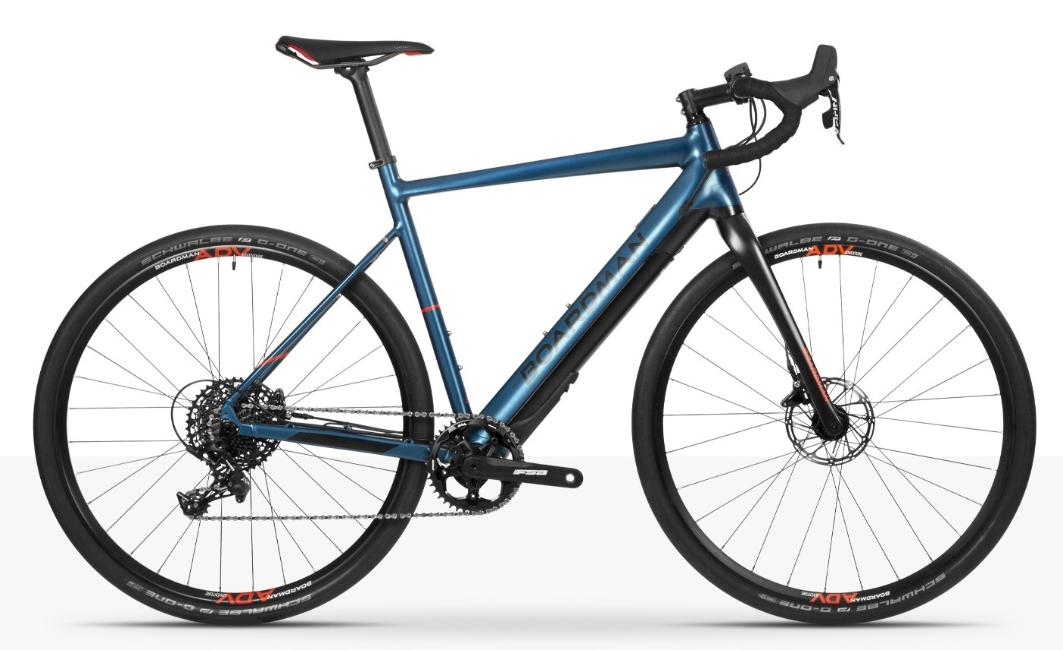
Photo Courtesy: Boardman
| Model Name | Weight | Range |
| Gtech eBike Sport | 35 lbs (16 kgs) | 30 miles (48 km) |
| Boardman ADV 8.9E | 10 lbs (4.6 kgs) | 55 miles (90 km) |
| Coboc One Soho | 30 lbs (13.7 kgs) | 50 miles (80 km) |
As the name suggests, road e-bikes are designed for smooth, paved roads. Their tires are skinny, high, and meant for fast riding. The drop handlebars can make riding a bit uncomfortable, so you need to master a bend or slouched position.
The purpose of the dropped handlebars is to make the rider more aerodynamic, so you achieve faster speeds without the wind slamming against your body and creating a wall that could slide you back. Instead, the wind will pass over your back.
Since road e-bikes are great for paved trails, they fail to produce a comfortable riding experience for unpaved or unstable trails. Don’t use these models for anything but racing or fast commuting, because the shocks and tires will not protect you against bumpy terrain.
Most road bikes aren’t suitable for carrying heavy loads, so they are not ideal for touring or commuting – just short rides with a backpack or long races. Since most e-bikes use GPS technology to calculate riding range, tech lovers will fit right in with the road e-bike crowd.
Road e-bikes a specifically for specialty riders that want to experience one type of bike riding. Since marathons are likely your thing, find an e-bike with a high capacity battery and motor because they both affect your riding experience more than any other criteria.
Some features, like staying comfortable long-term, will be more relevant if you plan to ride for an hour or longer per day. Weight and safety should also be a contributing factor, as well as the price and how that ties to your requirements.
Cyclocross/Gravel E-Bikes
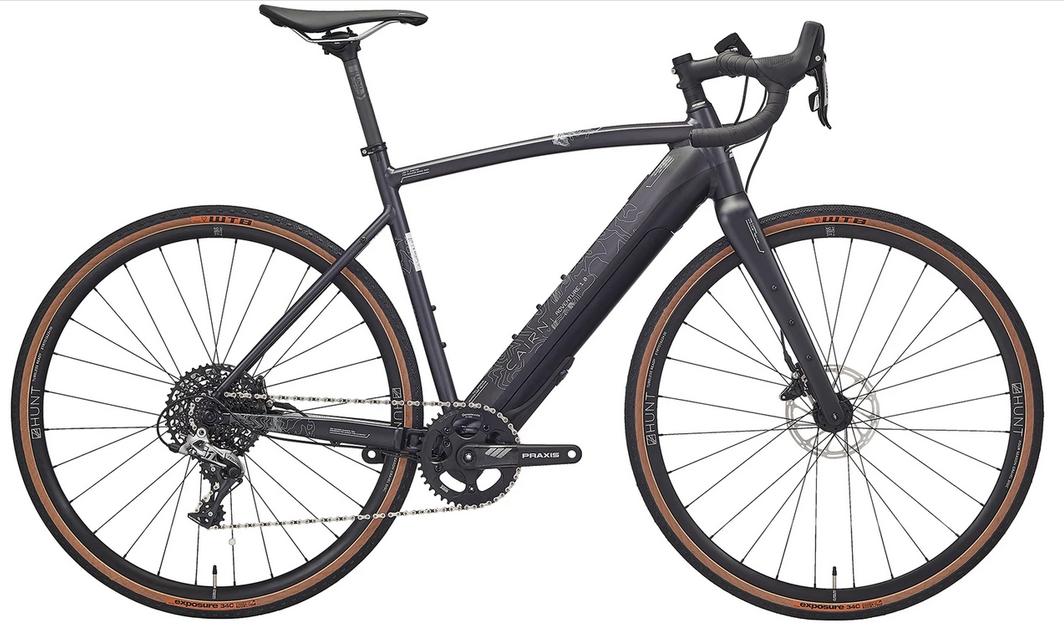
Photo Courtesy: Cairn Cycles
| Model Name | Weight | Range |
| BULLS GRINDER EVO | 53 lbs (24 kg) | 85 miles (135 km) |
| Cairn E-Adventure 1.0 | 32 lbs (14 kg) | 56 miles (90 km) |
| Yamaha Wabash | 42 lbs (19 kg) | 75 miles (120 km) |
Gravel or cyclocross e-bikes are a specialty type that is designed for racing on a mixed-surface course. Unlike road bikes, which can only ride on paved roads, the cyclocross model can ride on combination pavements, gravel, unpaved trails, and grass.
Cyclocross e-bikes have dropped handlebars like typical road bikes for less wind-resistance while riding, but the wheels are wider for better off-road traction. Gravel e-bikes also have a different style of brakes (usually disc brakes) to help prevent mud buildup on the frame.
You’ve probably heard of the term ‘cross bikes’ or ‘cx bikes’ in reference to road bikes because both the road bike and cyclocross models are confused for each other. Always check the tire width to be sure you’re picking the right model for your needs.
Keep in mind that gravel e-bikes came late in the e-bike game, which means you won’t have as many options in regards to price. For this reason, you may pick a mountain e-bike instead, but a cyclocross e-bike is actually cheaper than most high-end mountain bikes.
As for specs, you should concentrate more on your purpose for buying a gravel e-bike type. For racers, you should focus on the motor with enough power to scale steep inclines and travel through rough terrain. For casual riders, you won’t need to worry about the motor. Instead, focus on the battery and its charge time for longer commutes.
You’ll likely find a gravel e-bike for a reasonable price, but if you find that the price is similar to a mountain e-bike, just opt for one instead. Otherwise, try to find a balance of features (terrain, riding habits, and battery) for a better riding experience.
Cargo E-Bikes

Photo Courtesy: RadPower Bikes
| Model Name | Weight + Load Capacity | Range |
| RadWagon 4 | 60 lbs (27 kg) + 350 lbs (158 kg) | 45 miles (72 km) |
| Urban Arrow Shorty | 55 lbs (25 kg) + 400 lbs (181 kg) | 60 miles (96 km) |
| Tern Bicycles GSD S00 | 71 lbs (32 kg) + 440 lbs (200 kg) | 124 (200 km) |
For anyone who needs to travel long distances and carry a heavy load or a passenger, a cargo e-bike is perfect for you. We often don’t realize how much fuel it takes to carry more than one person, but you can cut an e-bikes range by more than half if you move too much weight.
Cargo e-bikes are also useful for the added stability of an often included extra tire. For this reason, they’re an excellent alternative to a motor-run tricycle or cars because of the added load capacity and the coolness factor. It’s often implied that tricycles are intended for kids.
This e-bike model often has a raised seat, flat handlebars, a large cargo basket in the front or back, and a large wheel in the front and a small tiny wheel in the back. Cargo e-bikes are more for functionally and utility, so if you want something that can go fast, get a smaller container in the front.
Should you opt for this model of e-bike to help you haul a wide variety of heavy things or averaged weighted people, but be careful when you’re shopping for one. Always prioritize the battery and motor, because if both of these don’t work in tandem, you’re not going to go far on a single charge.
Unfortunately, cargo e-bikes are some of the most expensive models available, especially if you want to carry loads of 400lbs or more. Be sure to factor in the bike’s weight before purchasing it; otherwise, you may miscalculate the load capacity and won’t be able to hold as much as you expect.
Adding more weight to a cargo e-bike than the manufacturer recommends could prematurely damage the motor and battery, or cause the e-bike to slow down. At that point, your e-bike won’t perform as well, which defeats the purpose of carrying more cargo.
Commuter E-Bikes
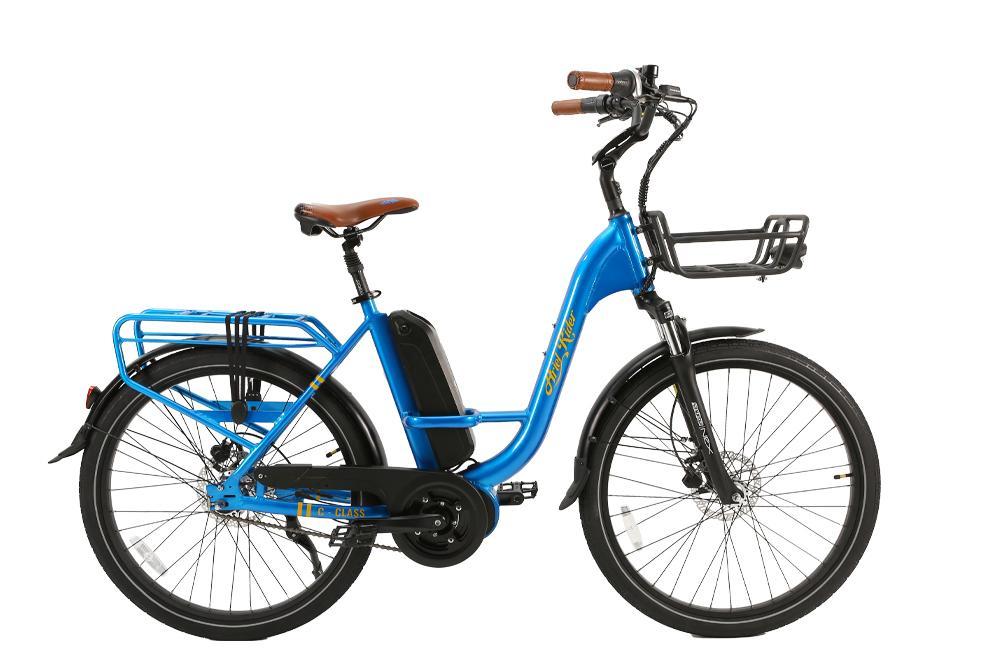
Photo Courtesy: Ariel Rider
| Model Name | Weight | Range |
| Ariel Rider C-Class | 62 lbs (28 kg) | 65 miles (104 km) |
| Trek Verve + 2 | 51 lbs (23 kg) | 82 miles (130 km) |
| RadCity 4 | 56 lbs (25 kg) | 44 miles (72 km) |
Most e-bikes are capable of getting the job done for short commutes, but a ‘commuter e-bike’ is in its own class because commuting is one of the most common e-bike uses. If you want a no-nonsense e-bike that gets you from point A to point B as comfortably as possible, choose a commuter bicycle.
A folding, city, and cruiser type could supplement for a commuter, but commuters tend to be more cost-effective because they don’t come with techy features that could jack up the price. Some city bikes often overlap with commuting types.
Since commuters often look and act like city models, you’ll find that the upright riding position is shared as it’s the most comfortable. Commuters also have larger, more shock absorbent wheels to protect against cobblestone or cracked sidewalks.
Comfort will be the most crucial feature of these models. Commuters are for daily bike rides, so ease of use is necessary. You shouldn’t ignore riding range or motor assist either because they need to fit your terrain and riding requirements.
Don’t overlook safety features, because you’ll be bobbing and weaving through traffic or pedestrians daily. Since commuters aren’t big on bonus features, you may need to pay a premium for GPS or display. If you want these features, keep in mind that many e-bike displays are purchasable after buying your e-bike.
Foldable E-Bikes

Photo Courtesy: Rad Power
| Model Name | Weight | Range |
| RadMini 4 | 67 lbs (30 kg) | 45 miles (72 km) |
| Gocycle GS | 49 lbs (22 kg) | 45 miles (72 km) |
| Swagtron EB7 | 48 lbs (21 kg) | 15.5 miles (24 km) |
Foldable e-bikes are bicycles that fold, usually in half, and are ideal for anyone who needs to travel with their e-bike. Some commutes take longer than 25 minutes and may require the rider to hop on a subway, bus, or train. Bringing along a foldable e-bike can help with that.
As an alternative, foldable e-bikes are perfect for anyone who wants to bike in a foreign country and wants to pack it on a flight, or if the rider lives in a small apartment will little storage space. You can also store these models under your desk once you get to work for safekeeping.
Most foldable e-bikes have smaller wheels, making them less efficient and harder to handle than a typical commuter. Think of a folding e-bike like a BMX, as they tend to be low to the ground, more compact, and require the rider to slouch.
One immediate concern for anyone who wants to use a foldable e-bike is its weight. Most e-bikes are more substantial because of the motor and battery, but if you aren’t capable of lugging around 50 lbs, find an e-bike that weighs 30 lbs or less for your comfort.
Riding range and motor power will be necessary, but it’s unlikely you’ll find a model capable of a lot of power or range that exceeds 44 miles (72 km) unless you want to pay a hefty price for it. Also, look at the motor size on the bike once folded, because it may jut out too much.
Expect to pay more than your average commuter. The technology required to make an e-bike foldable, light, and capable enough to carry a decent load capacity is always expensive. Folding e-bikes tend to be more economical than other types of electric bikes.
Are you an e-bike enthusiast?
Are you interested in many other articles, like this one, that gives in-depth information about different e-bike models?
Browse our site for more information on the best electric bikes and scooters that can make your commute more stylish and fun.
Before you go, leave a comment on your favorite class or model of e-bike or read one of our other articles about the history of bicycles and e-bikes.


